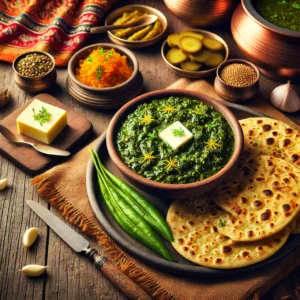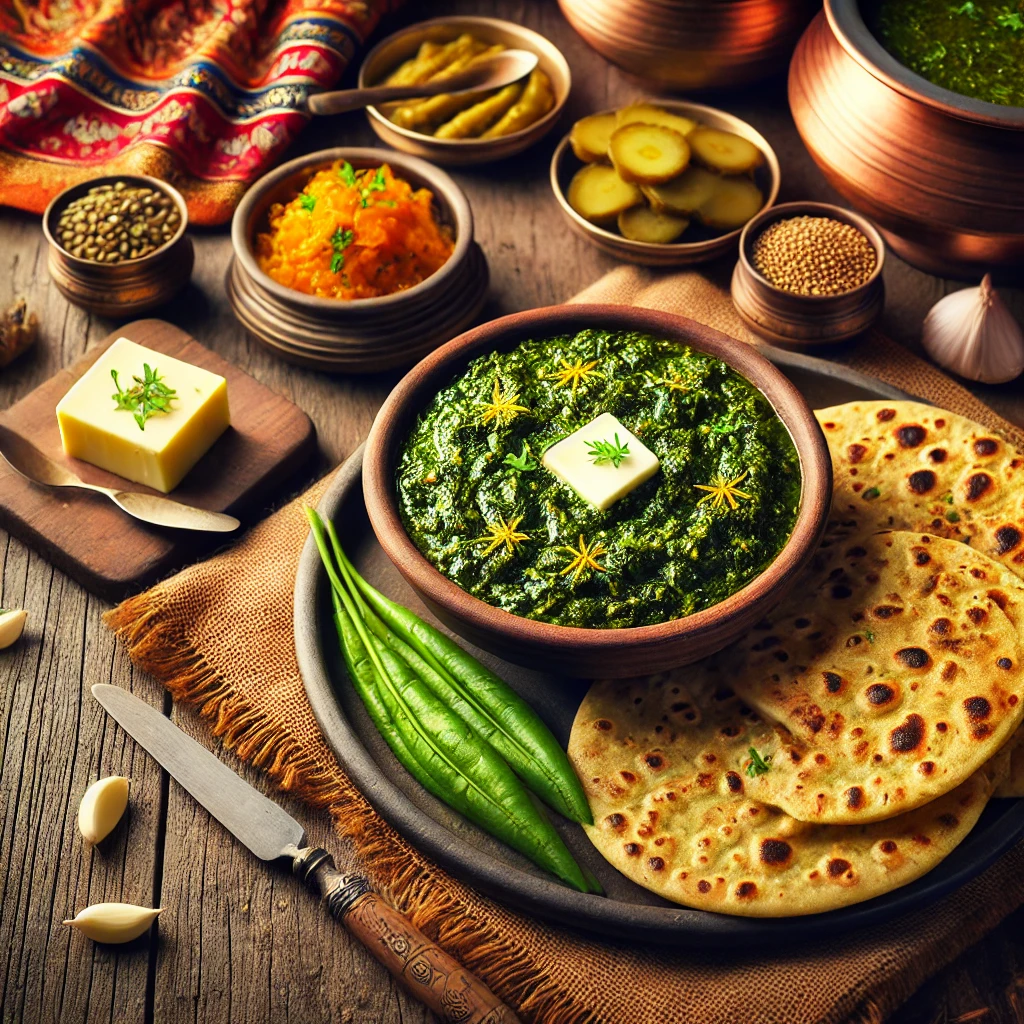When one thinks of Punjabi cuisine, the iconic combination of Makke Di Roti and Sarson Ka Saag often comes to mind. This beloved duo is not just a dish; it’s a celebration of North India’s rich agricultural heritage, culinary traditions, and the warmth of home-cooked meals. Revered across the northern plains of India, particularly in Punjab, this hearty meal finds its place in almost every household during the winter months. Its deep-rooted connection to the land and the season makes it more than just a dish; it’s a cultural emblem.
A Winter Delight
Makke Di Roti, a flatbread made from cornmeal, and Sarson Ka Saag, a flavorful curry made from mustard greens, are particularly favored in winter. The cold months bring with them a bounty of mustard greens, which are rich in nutrients and are known to thrive in the chilly climate of North India. The consumption of Sarson Ka Saag during winter is not just a matter of tradition but also a nod to its nutritional value. Mustard greens are packed with essential vitamins like A, C, and K, along with minerals such as calcium and iron, which help bolster immunity and keep the body warm.
The dense and fibrous nature of Makke Di Roti, on the other hand, provides the much-needed energy to stay active during the colder days. Its earthy flavor complements the robust taste of the saag, creating a harmonious blend of textures and flavors that is both satisfying and wholesome.
A Dish Loved Across Borders
While its origins lie in Punjab, Makke Di Roti and Sarson Ka Saag have transcended regional boundaries to become a staple in many North Indian states, including Haryana, Himachal Pradesh, and even parts of Uttar Pradesh. Each region may have its slight variations in preparation, but the essence remains the same. It’s a dish that brings people together, whether during a family gathering or a festive occasion.
The love for this dish is so profound that many urban restaurants and dhabas (roadside eateries) have adopted it into their menus, bringing a taste of rural Punjab to city dwellers. It’s not uncommon to find people reminiscing about their childhood as they relish a plate of this rustic delicacy, recalling memories of grandmothers making Makke Di Roti on a clay tawa (griddle) and the aroma of freshly cooked saag filling the air.
Health Benefits
Apart from its rich, comforting taste, Makke Di Roti Sarson Ka Saag is a powerhouse of health benefits. Mustard greens are known for their anti-inflammatory properties and their ability to improve heart health. They are a rich source of antioxidants, which help in fighting free radicals in the body, thus reducing the risk of chronic diseases.
Cornmeal, the primary ingredient in Makke Di Roti, is gluten-free, making it a good option for those with gluten intolerance. It is also high in fiber, which aids in digestion and helps maintain a healthy gut. The use of ghee or butter in this dish, while adding to its caloric value, also contributes to providing the necessary healthy fats required during winter for keeping the body warm and energetic.
Cultural Significance
In many ways, Makke Di Roti Sarson Ka Saag represents the agrarian lifestyle of Punjab. The mustard fields, which turn the landscape into a sea of yellow, are not only a visual treat but also a symbol of prosperity and the hard work of the farmers. Harvesting mustard greens and corn is an integral part of the rural economy, and this dish pays homage to that.
Festivals like Lohri and Makar Sankranti, which mark the harvest season, often feature Makke Di Roti and Sarson Ka Saag as a must-have on the dining table. These festivals celebrate the bounty of nature and the joy of togetherness, and this dish fits perfectly into that narrative.
A Comforting Bowl of Tradition
Makke Di Roti Sarson Ka Saag is more than just food; it is a comforting embrace of tradition, health, and flavor. It tells the story of a land that values its roots, of a cuisine that is as nourishing as it is delicious, and of a people who take pride in their culinary heritage. Whether enjoyed in a rustic village setting or a modern urban kitchen, this dish remains a timeless favorite that continues to warm hearts and homes alike.

Sarson Ka Saag with Makke Di Roti
Ingredients
For Sarson Ka Saag
- 250 g Mustard Greens (Sarson)
- 100 g Spinach (पालक)
- 1 no. onion finely chopped
- 2 no. Green Chillies chopped
- 1 inch Ginger grated
- 3 no. Garlic Clove minced
- 2 tbsp Maize Flour (Makki ka atta)
- 2 tbsp Butter or Ghee
- 1 tsp Cumin seeds (जीरा)
- salt to taste
- water as needed
For Makke Di Roti
- 1 cup Maize Flour Makki ka atta
- Warm water for kneading
- salt to taste
- Ghee or Butteer for cooking
Instructions
Sarson Ka Saag
- Wash and roughly chop mustard greens and spinach.
- Boil the greens with a little water until soft (about 15-20 minutes). Drain and cool.
- Blend the greens to a coarse paste.
- Heat ghee in a pan, add cumin seeds, and let them splutter.
- Add onions, ginger, garlic, and green chilies. Sauté until onions are golden brown.
- Add the green paste and cook for 5-7 minutes on low heat.
- Mix maize flour with a little water to form a slurry. Add this to the saag and stir well to avoid lumps.
- Cook for another 10-15 minutes, stirring occasionally. Season with salt.
Makke Di Roti
- In a bowl, mix maize flour with a pinch of salt. Gradually add warm water and knead into a soft dough.
- Divide the dough into equal portions and roll out into thick discs.
- Heat a tawa (griddle) and cook the roti on both sides until golden brown, applying ghee or butter as needed.
- Serve hot with Sarson Ka Saag, a dollop of butter, and optional pickles.

